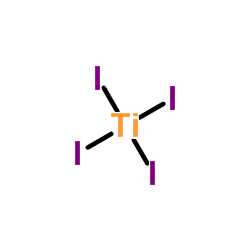Titanium(IV) iodide

Titanium(IV) iodide structure
|
Common Name | Titanium(IV) iodide | ||
|---|---|---|---|---|
| CAS Number | 7720-83-4 | Molecular Weight | 555.485 | |
| Density | 4.3 g/cm3 | Boiling Point | 377,1ºC | |
| Molecular Formula | I4Ti | Melting Point | 150-151ºC | |
| MSDS | Chinese USA | Flash Point | N/A | |
| Symbol |

GHS05 |
Signal Word | Danger | |
| Name | titanium (iv) iodide |
|---|---|
| Synonym | More Synonyms |
| Density | 4.3 g/cm3 |
|---|---|
| Boiling Point | 377,1ºC |
| Melting Point | 150-151ºC |
| Molecular Formula | I4Ti |
| Molecular Weight | 555.485 |
| Exact Mass | 555.565796 |
| LogP | 3.54280 |
|
Section 1: Product Identification Chemical Name:Titanium (IV) iodide (99.99%-Ti) PURATREM CAS Registry Number:7720-83-4 Formula:TiI4 EINECS Number:231-754-0 Chemical Family:metal halide Synonym:Titanium tetraiodide
Section 2: Composition and Information on Ingredients IngredientCAS NumberPercentACGIH (TWA)OSHA (PEL) Title Compound7720-83-4100%no datano data Section 3: Hazards Identification Corrosive to skin, eyes, and mucous membranes. May cause coughing, wheezing, shortness of breath, Emergency Overview: headache, nausea and vomiting. Ingestion may cause damage to the mouth, throat and esophagus. Primary Routes of Exposure:Ingestion, inhalation, skin, eyes. Eye Contact:Corrosive to eyes. Skin Contact:Corrosive to skin. Inhalation:Inhalation may cause inflammation of the respiratory tract, edema and chemical pneumonitis. Ingestion:Ingestion may cause damage to the mouth, throat and esophagus. Corrosive to skin, eyes and mucous membranes. Inhalation causes coughing, wheezing, shortness of breath, Acute Health Affects: headache, nausea, and vomiting. Ingestion may cause damage to the mouth throat and esophagus. Chronic ingestion of iodides may produce iodism. Symptoms include skin rash, running nose, headache and Chronic Health Affects: irritation of mucous membranes. NTP:No IARC:No OSHA:No SECTION 4: First Aid Measures Immediately flush the eyes with copious amounts of water for at least 10-15 minutes. A victim may need Eye Exposure: assistance in keeping their eye lids open. Get immediate medical attention. Wash the affected area with water. Remove contaminated clothes if necessary. Seek medical assistance if Skin Exposure: irritation persists. Remove the victim to fresh air. Closely monitor the victim for signs of respiratory problems, such as difficulty Inhalation: in breathing, coughing, wheezing, or pain. In such cases seek immediate medical assistance. Seek medical attention immediately. Keep the victim calm. Give the victim water (only if conscious). Induce Ingestion: vomiting only if directed by medical personnel. SECTION 5: Fire Fighting Measures Flash Point:not applicable Autoignition Temperature:none Explosion Limits:none Extinguishing Medium:none required If involved in a fire, fire fighters should be equipped with a NIOSH approved positive pressure self-contained Special Fire Fighting Procedures: breathing apparatus and full protective clothing. Hazardous Combustion andIf involved in a fire this material may emit corrosive hydrogen iodide fumes. Decomposion Products: Unusual Fire or Explosion Hazards: No unusual fire or explosion hazards. SECTION 6: Accidental Release Measures Small spills can be mixed with powdered sodium bicarbonate, lime, or calcium carbonate and swept up. Spill and Leak Procedures:Spillage in areas not adequately ventilated may require an evacuation of area. Emergency response teams will require self-contained breathing apparatus. SECTION 7: Handling and Storage Store material in a tightly sealed bottle away from moisture. If possible, handle material in an efficient fume Handling and Storage: hood. Prolonged exposure to the atmosphere may lead to degradation of the product. SECTION 8: Exposure Controls and Personal Protection Eye Protection:Always wear approved safety glasses when handling a chemical substance in the laboratory. Skin Protection:Wear protective clothing and gloves. Consult with glove manufacturer to determine the proper type of glove. Ventilation:If possible, handle the material in an efficient fume hood. In the absence of adequate ventilation a respirator should be worn. The use of a respiratory requires a Respirator: Respirator Protection Program to be in compliance with 29 CFR 1910.134. Ventilation:If possible, handle the material in an efficient fume hood. Additional Protection:No additional protection required. SECTION 9: Physical and Chemical Properties Color and Form:black xtl. Molecular Weight:555.52 Melting Point:150° Boiling Point:377.1°C Vapor Pressure:no data Specific Gravity:4.3 Odor:Pungent odor. Solubility in Water:reacts with water SECTION 10: Stability and Reactivity Stability:moisture sensitive Hazardous Polymerization:no hazardous polymerization Conditions to Avoid:contact with moisture Incompatibility:Oxidizing agents, water, alcohols, active metals and halogens Decomposition Products:with moisture: hydrogen iodide SECTION 11: Toxicological Information RTECS Data:No information available in the RTECS files. Carcinogenic Effects:no data Mutagenic Effects:no data Tetratogenic Effects:no data SECTION 12: Ecological Information Ecological Information:No information available SECTION 13: Disposal Considerations Disposal:Dispose of according to local, state and federal regulations. SECTION 14: Transportation Shipping Name (CFR):Corrosive Solid, Acidic, Inorganic, N.O.S. Hazard Class (CFR):8 Additional Hazard Class (CFR):NA Packaging Group (CFR):II UN ID Number (CFR):UN# 3260 Shipping Name (IATA):Corrosive Solid, Acidic, Inorganic, N.O.S. Hazard Class (IATA):8 Additional Hazard Class (IATA):NA Packaging Group (IATA):II UN ID Number (IATA):UN# 3260 SECTION 15: Regulatory Information TSCA:Listed in the TSCA inventory. SARA (Title 313):Title compound not listed. Second Ingredient:none SECTION 16 - ADDITIONAL INFORMATION N/A |
| Symbol |

GHS05 |
|---|---|
| Signal Word | Danger |
| Hazard Statements | H314 |
| Precautionary Statements | P280-P305 + P351 + P338-P310 |
| Personal Protective Equipment | Eyeshields;Faceshields;full-face particle respirator type N100 (US);Gloves;respirator cartridge type N100 (US);type P1 (EN143) respirator filter;type P3 (EN 143) respirator cartridges |
| Hazard Codes | C |
| Risk Phrases | R34 |
| Safety Phrases | 26-36/37/39-45 |
| RIDADR | UN3260 |
| Packaging Group | II |
|
~% 
Titanium(IV) iodide CAS#:7720-83-4 |
| Literature: Ann. Chim. Phys., , vol. 9, p. 229 - 237 Comptes Rendus Hebdomadaires des Seances de l'Academie des Sciences, , vol. 120, p. 290 - 296 Ti: MVol., 3.5, page 189 - 199 |
|
~% 
Titanium(IV) iodide CAS#:7720-83-4 |
| Literature: Bulletin de la Societe Chimique de France, , p. 201 - 203 Jahresbericht ueber die Fortschritte der Chemie und Verwandter Theile Anderer Wissenschaften, , p. 207 |
|
~% 
Titanium(IV) iodide CAS#:7720-83-4 |
| Literature: Bulletin de la Societe Chimique de France, , p. 201 - 203 Jahresbericht ueber die Fortschritte der Chemie und Verwandter Theile Anderer Wissenschaften, , p. 207 |
|
~0% 
Titanium(IV) iodide CAS#:7720-83-4 |
| Literature: Denes Georges Journal of Solid State Chemistry, 1988 , vol. 77, p. 54 - 59 |
|
~% 
Titanium(IV) iodide CAS#:7720-83-4 |
| Literature: Bulletin de la Societe Chimique de France, , vol. 7, p. 198 Bulletin de la Societe Chimique de France, , vol. 7, p. 201 - 201 I: MVol.2, 21, page 291 - 293 |
|
~99% 
Titanium(IV) iodide CAS#:7720-83-4 |
| Literature: Troyanov, S. I.; Mazo, G. N. Russian Journal of Inorganic Chemistry (Translation of Zhurnal Neorganicheskoi Khimii), 1988 , vol. 33, p. 499 - 501 Zhurnal Neorganicheskoi Khimii, 1988 , vol. 33, p. 889 - 892 |
|
~% 
Titanium(IV) iodide CAS#:7720-83-4 |
| Literature: Journal of Physical Chemistry, , vol. 8, p. 500 - 504 |
| Precursor 5 | |
|---|---|
| DownStream 5 | |
| iodine titanium |
| Titanium(4+) tetraiodide |
| MFCD00043077 |
| Titanium (IV) iodide |
| Titanium(IV) iodide |
| EINECS 231-754-0 |
| titanium iodide |
| TITANIUM TETRAIODIDE |
| iodide titanium |






 CAS#:13455-01-1
CAS#:13455-01-1 CAS#:13450-95-8
CAS#:13450-95-8